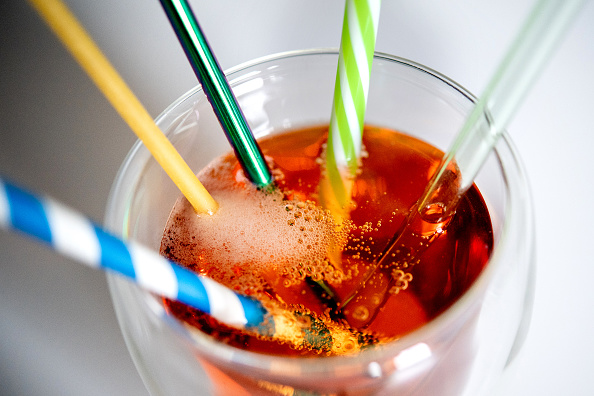Products Made With Captured Greenhouse Gas Are Reaching Commercial Scale
Startups are taking aim at chemicals, one of the largest industrial sources of global emissions
Straws, bottles and packaging made with captured greenhouse-gas are starting to reach commercial scale, offering a way for businesses making and using everyday products to reduce emissions contributing to global warming.
Locking up greenhouse gas in ingredients that go into products can be costly compared with petroleum-based options and presents hurdles to building out enough infrastructure to capture emissions. Even so, big companies are increasingly willing to pay a so-called green premium for products that help reduce their carbon footprints by seeking alternatives to plastic and other materials made with petroleum.
Origin Materials Inc. and Newlight Technologies Inc. are trying to meet that demand by bringing factories online that use captured emissions to manufacture materials used to make products including clothes, tires and plastic bottles. The two companies have signed deals with Target Corp., Ford Motor Co. and other companies hoping to reduce emissions in supply chains and from the use of their goods.
“If we could use carbon emissions as a resource to create useful products, then potentially we could create a consumer-driven pathway to reducing carbon in the air,” said Newlight Chief Executive Mark Herrema. Sourcing and transporting raw inputs and captured CO2 are crucial to a product’s so-called carbon-negative credentials, meaning more CO2 is stored than created.
Mr. Herrema said he expects Newlight’s costs to fall as production scales up, adding the Huntington Beach, Calif.-based company’s foodware products are already priced competitively with other sustainable options. He said there are many sources for emissions, but more infrastructure to capture them is needed.
Newlight in 2020 opened its first commercial-scale factory in Huntington Beach. It manufactures foodware, such as cutlery, bowls and straws, for Shake Shack Inc., Walt Disney Co. and Hyatt Hotels Corp. among others. Newlight said the factory has produced more than 50 million foodware units.
The company took about a decade to develop a process using microbes that suck up methane or carbon dioxide to grow a biological material called polyhydroxybutyrate, which is used to make biodegradable resins that can replace plastic. The private company sources captured emissions from dairy farms, ethanol plants and landfills, and is expanding into coal mines and exploring direct-air capture.
“Nature’s favorite food source is greenhouse gas,” Mr. Herrema said. “Do what nature does, turn it into useful goods.”
The startups are taking aim at chemicals that are an essential part of many consumer goods. The sector is the third-largest industrial source of greenhouse gas emissions globally and is on pace to produce more unless new technologies go into widespread use, according to the International Energy Agency.
Making chemicals that capture emissions faces two barriers, according to chemical industry analysts: reducing costs sufficiently to compete with petroleum-based chemical manufacturing and sourcing enough captured emissions or raw materials.
“The market for captured-carbon-based fuels and products is still relatively limited due to technology and cost constraints,” said Mitch Toomey, vice president of sustainability and responsible care at the American Chemistry Council trade association.
Mr. Herrema said Newlight is also in talks with Nike Inc. and Sumitomo Chemical Co. Ltd. to use its materials in apparel and automotive machinery. Previously, Newlight had agreements with IKEA and Dell Technologies to provide packaging, but Mr. Herrema said his company decided over the past few years to focus on serving foodware, fashion and automotive companies until it grows.
Newlight’s next factory is slated to come online in 2025 in Ohio, which will tap methane from a coal mine through an agreement with CNX Resources Corp. The CNX deal will supply between 1 million to 36 million metric tons of carbon-dioxide equivalent, with the likely amount somewhere in the middle, said Ravi Srivastava, president of new technologies at CNX. He said the mine is one of only five with a capture system in place, among more than 2,000 coal mines across the U.S. The companies declined to share financial terms of the deal and what portion of the mine’s emissions it will cover.
Competitor Origin Materials has a different approach to acquiring captured emissions and plans for its first commercial-scale factory to come online next year.
The West Sacramento, Calif.-based company already has $9 billion in orders from companies including Primaloft to make bedding and apparel and Ford for automotive parts, and expects to be profitable by 2025 after its second commercial-scale plant opens.
Through a chemical process, Origin Materials converts organic materials, which lock up carbon dioxide from when they were growing, for use in polyethylene terephthalate, or PET, plastic commonly found in packaging and other synthetic products. The company’s offerings will be cost competitive with petroleum-derived versions because the ingredients it uses are abundant and cheap, co-CEO John Bissell said.
“There are a lot of these materials globally,” Mr. Bissell said. “If we’re at the point that we are using all of those things, we’ve won the game if we are starting to run out of feedstock.”
 Copyright 2020, Dow Jones & Company, Inc. All Rights Reserved Worldwide. LEARN MORE
Copyright 2020, Dow Jones & Company, Inc. All Rights Reserved Worldwide. LEARN MORE
This stylish family home combines a classic palette and finishes with a flexible floorplan
Just 55 minutes from Sydney, make this your creative getaway located in the majestic Hawkesbury region.
Continued stagflation and cost of living pressures are causing couples to think twice about starting a family, new data has revealed, with long term impacts expected
Australia is in the midst of a ‘baby recession’ with preliminary estimates showing the number of births in 2023 fell by more than four percent to the lowest level since 2006, according to KPMG. The consultancy firm says this reflects the impact of cost-of-living pressures on the feasibility of younger Australians starting a family.
KPMG estimates that 289,100 babies were born in 2023. This compares to 300,684 babies in 2022 and 309,996 in 2021, according to the Australian Bureau of Statistics (ABS). KPMG urban economist Terry Rawnsley said weak economic growth often leads to a reduced number of births. In 2023, ABS data shows gross domestic product (GDP) fell to 1.5 percent. Despite the population growing by 2.5 percent in 2023, GDP on a per capita basis went into negative territory, down one percent over the 12 months.
“Birth rates provide insight into long-term population growth as well as the current confidence of Australian families,” said Mr Rawnsley. “We haven’t seen such a sharp drop in births in Australia since the period of economic stagflation in the 1970s, which coincided with the initial widespread adoption of the contraceptive pill.”
Mr Rawnsley said many Australian couples delayed starting a family while the pandemic played out in 2020. The number of births fell from 305,832 in 2019 to 294,369 in 2020. Then in 2021, strong employment and vast amounts of stimulus money, along with high household savings due to lockdowns, gave couples better financial means to have a baby. This led to a rebound in births.
However, the re-opening of the global economy in 2022 led to soaring inflation. By the start of 2023, the Australian consumer price index (CPI) had risen to its highest level since 1990 at 7.8 percent per annum. By that stage, the Reserve Bank had already commenced an aggressive rate-hiking strategy to fight inflation and had raised the cash rate every month between May and December 2022.
Five more rate hikes during 2023 put further pressure on couples with mortgages and put the brakes on family formation. “This combination of the pandemic and rapid economic changes explains the spike and subsequent sharp decline in birth rates we have observed over the past four years,” Mr Rawnsley said.
The impact of high costs of living on couples’ decision to have a baby is highlighted in births data for the capital cities. KPMG estimates there were 60,860 births in Sydney in 2023, down 8.6 percent from 2019. There were 56,270 births in Melbourne, down 7.3 percent. In Perth, there were 25,020 births, down 6 percent, while in Brisbane there were 30,250 births, down 4.3 percent. Canberra was the only capital city where there was no fall in the number of births in 2023 compared to 2019.
“CPI growth in Canberra has been slightly subdued compared to that in other major cities, and the economic outlook has remained strong,” Mr Rawnsley said. “This means families have not been hurting as much as those in other capital cities, and in turn, we’ve seen a stabilisation of births in the ACT.”
This stylish family home combines a classic palette and finishes with a flexible floorplan
Just 55 minutes from Sydney, make this your creative getaway located in the majestic Hawkesbury region.






















